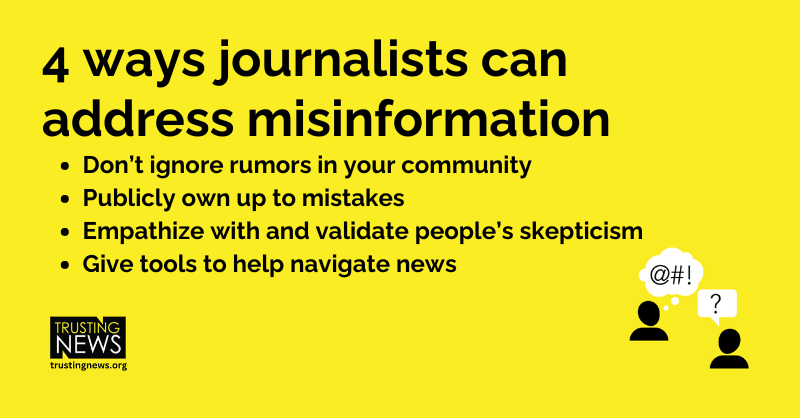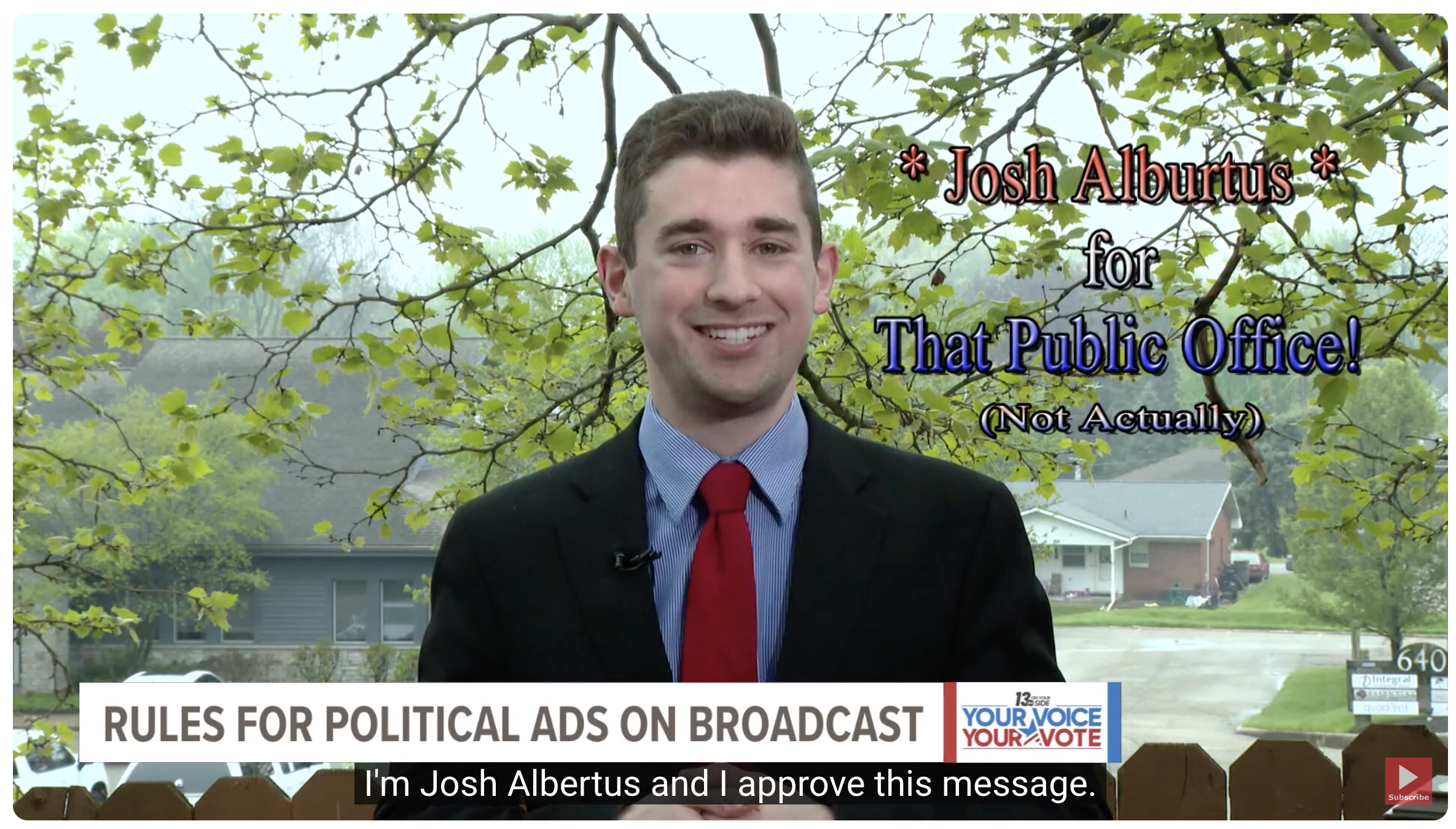
At Trusting News, we’re often asked how journalists should handle misinformation. This is not surprising, given how both the public and journalists agree it’s a major issue. But research shows that as much as journalists think it’s a problem, they rarely address it in their reporting. (In this Pew study, two-thirds said almost none of […]
Journalists, address misinformation head-on
At Trusting News, we’re often asked how journalists should handle misinformation. This is not surprising, given how both the public and journalists agree it’s a major issue.
But research shows that as much as journalists think it’s a problem, they rarely address it in their reporting. (In this Pew study, two-thirds said almost none of the stories they worked on in the past year had to do with false or made-up information.)
Another concerning research point: A recent study by the Media Insight Project found that about half of adults are concerned that news organizations report inaccurate or unverified information.
If half of the public is unsure if we’re posting credible, verified information, why would they turn to us as a source of information? (We know one answer — many aren’t!)
As much as we wish doubling down on doing fair, accurate reporting would be enough to change the public’s perception of the news, we know more is needed. If we want people to be able to decipher good information from bad, to turn to us as a credible news source and to trust that we work to combat misinformation, we have to start addressing it publicly.
Here are some ways journalists can do that.
Don’t ignore rumors
When misinformation arises in our communities, especially in conversation spaces your newsroom owns or helps moderate, it often does more harm to not acknowledge it. Instead, address it and set the record straight.
We’ve shared this example from reporter Vic Micolucci of WJXT in Jacksonville before, and we continue to appreciate how he directly addressed when rumors were swirling online that journalists had altered photos of Florida beaches reopening during the coronavirus pandemic.
It’s perhaps most important to address misinformation and rumors when they are active and spreading. But we also encourage you to talk to your audience about your newsroom’s approach to handling misinformation more generally. Talk about how you don’t tolerate or spread misinformation. Be honest that it’s an issue for you too, and how it impacts your credibility and your reporting. And then if you can, back up those claims with specific examples from your reporting.
Publicly own up to mistakes
We know some journalists are concerned about making their corrections too visible. Won’t that make people question your reporting even more if they know you make mistakes? But research from Pew shows the opposite — seeing corrections to news stories actually increases people’s confidence in the work.
If the public already thinks journalists don’t care about getting it right and are worried journalists are publishing unverified mistakes, then it’s important we start addressing our mistakes publicly. That lack of faith in our commitment to accuracy is often cited as a reason for low trust.
Our own research with the Center for Media Engagement showed that people who lean right pointed to prominently correcting errors as a key factor in trust. Do it consistently, and consider explaining how an error occurred and why the correction was necessary. Our corrections Trust Kit can help you audit your own practices.
Empathize with people, and validate skepticism
We can often categorize people who share and believe misinformation as far beyond the realms of reality and totally unreachable. “Those people” must not care about facts, right? Or worse, they might be trying to manipulate those around them.
Remember, though, that many people are well-intentioned when it comes to the accuracy of information, but they just lack the skepticism and tools to be able to discern what’s credible.
Also, it’s good to remember that everyone (even journalists) is susceptible to misinformation. I was recently on a National Press Club panel with Dr. Kate Starbird at the University of Washington, and she reiterated that no one is immune to this problem. She reminded us that we’re all vulnerable, especially in these moments of chaos and uncertainty.
With this in mind, can we try to extend more empathy to our audiences when they share information that’s not legit? Can we encourage them to be skeptical and make thoughtful, careful choices? To validate that it’s smart for people to be wary of what they see online and that they should absolutely question the values and options that drive information? And can we point them to resources and tools that might help them do this?
Help people navigate the news
Consuming news is overwhelming, especially when you’re not easily able to tell fact from fiction. This overwhelm, we know, causes lots of people to decide to just tune out of the news altogether.
As journalists, we can help by talking directly to our audiences about ways they can be smart about their news consumption — of our products and others. Give them tools and resources to help decipher if what they’re seeing is bad information. You don’t have to write those explainers yourself. Link to what other organizations have put together, like the News Literacy Project and PEN America. The News Literacy Project’s Rumor Guard is a great place to start.
Make those explanations a standing part of a newsletter or social strategy, and even better, share them alongside resources when there is misinformation happening.
Share what makes your news different
Whether we like it or not, we’re lumped together with every other information source out there. That’s why it’s so important for us to equip people to tell the difference between credible news and non-credible news — and share what makes our news trustworthy.
We have many ideas for how journalists can do this, but a good starting point is explaining some key facts about your reporting process.
When to NOT talk about misinformation
There are of course legitimate arguments for not covering certain rumors or misinformation. There may be times when discussing misinformation might bring more unwarranted attention to unverified claims.
While it’s up to individual newsrooms and journalists to decide on a case-by-case basis what makes the most sense for their community, we want to point you this helpful list from First Draft to ask before covering misinformation.
- How much engagement has the rumor received, and how do these numbers compare to similar content on the platform?
- Is the discussion around the rumor limited to one community online?
- Has the rumor jumped platforms?
- Did an influencer or verified account share the rumor?
- Have large media outlets covered it rumor?
While there’s no simple answer, even just stating that your goal is to thwart the spread of misinformation can help people better understand your mission.
If our team can help offer insights and brainstorming while you weigh these decisions, please reach out by emailing us at info@trustingnews.org or by messaging us on LinkedIn.
At Trusting News, we learn how people decide what news to trust and turn that knowledge into actionable strategies for journalists. We train and empower journalists to take responsibility for demonstrating credibility and actively earning trust through transparency and engagement. Subscribe to our Trust Tips newsletter. Follow us on Twitter and Facebook. Read more about our work at TrustingNews.org.

Project manager Mollie Muchna (she/her) has spent the last 10 years working in audience and engagement journalism in local newsrooms across the Southwest. She lives in Tucson, Arizona, where she is also an adjunct professor at the University of Arizona’s School of Journalism. She can be reached at mollie@trustingnews.org and on Twitter @molliemuchna.



